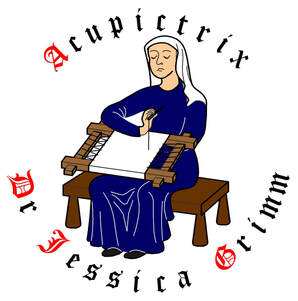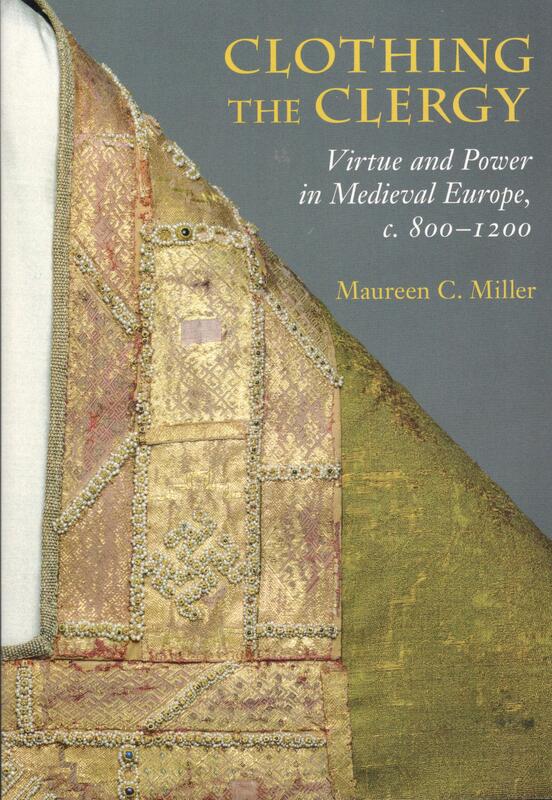|
If you are after a book with lots of pretty pictures of medieval embroidery on vestments, this is not it. Yes, there are some pretty pictures in there, but it is not what the book is all about. Why do I still think it is worth your time? It has a very interesting chapter on the role of women in making vestments and donating them. As the author places their making into the wider context of church reform during the Middle Ages, it explains a lot about the position of women today in the Western world. From the late 12th-century onwards, increased urbanisation leads to a dominance of the textile trades by men. Especially the 'higher end' of the market is dominated by them. That's why I have written in several blog posts that certain vestments I saw in museums were most likely made by men. The written data for the Late medieval period and beyond from the Netherlands does, for instance, not mention one female embroiderer. But this had not always been the case. The author, Maureen Miller, writes that when we know the name of the maker of earlier vestments, it is always a woman. And here the labour is divided up too: slaves for the 'hard labour' of growing, spinning, weaving, dying etc. and elite women for the fashioning of the vestment. For the more elaborate vestments, male religious would assist with the designing. Why would women spend time and money on creating (and maintaining) these elaborate vestments? Maureen Miller comes up with several explanations. Firstly, from the ninth century, ecclesiastical legislation prohibited women from entering the church sanctuary or come near the altar. By providing vestments, these women were present at the altar. Secondly, by cultivating such a relationship with clergy, these women could exercise some influence for themselves, but most likely for their families. Maureen Miller thus rightly asks how freely were these gifts really given? In addition, these relationships between elite women and clergy were always viewed with suspicion. On the one side, elaborate stories about the piety of the women who worked these vestments were drawn up (reciting scripture or singing psalms whilst working). On the other hand, there were plenty of stories in which the 'lewdness of the female maker' transferred through the vestments onto the wearer. These poor clergy felt mightily uneasy when it came to women making and maintaining their intimate clothing.
At the same time, there is a wider reform going on in the church. In order to claim status and visualise hierarchy, an ornate style of vestments started to emerge in the 9th century in Anglo-Saxon England and Francia (modern-day Normandy and parts of Belgium). By the 11th-century it had spread throughout Europe. The makers of this new ornate style were women. They (unwittingly?) provided part of the means with which the Gregorian reforms could be implemented (most notably clerical celibacy). These were particularly bad for the position of European women as they emphasised extreme notions of purity. These ideas live on in particular in the Catholic church till today. And those poor holy men? They were relieved when they could order their splendid vestments from men in urban centres. They no longer needed to foster close relationships with women to obtain and maintain their vestments. For the visualisation of their status, they no longer depended on women. Women lost a way to exercise their influence. But they lost so much more. Till today, in many Christian traditions, women are not seen as pure enough to serve at the altar. Argue in the other direction and time might have come to strip these holy men of their fancy clothes in order to restore some much-needed balance between the sexes! Literature Miller, M.C. (2014): Clothing the clercy. Virtue and power in Medieval Europe, c. 800-1200. Cornell University Press.
6 Comments
Marina Berts
6/7/2020 15:41:54
How interesting! Thank you very much for your review, I'm very tempted to order the book. Always fascinating to read about women that most often are the forgotten ones in History.
Reply
6/7/2020 16:52:29
You should, Marina! I haven't read such a good book in a long time. One chapter was a bit dry, but all the others were highly interesting.
Reply
6/7/2020 16:53:29
Thank you Meri! I found the conclusions from the book rather provoking. But it could explain a lot.
Reply
7/7/2020 21:47:12
Indeed there are! And the stories they came up with are so ridiculous.
Reply
Your comment will be posted after it is approved.
Leave a Reply. |
Want to keep up with my embroidery adventures? Sign up for my weekly Newsletter to get notified of new blogs, courses and workshops!
Liked my blog? Please consider making a donation or becoming a Patron so that I can keep up the good work and my blog ad-free!
Categories
All
Archives
July 2024
|
Contact: info(at)jessicagrimm.com
Copyright Dr Jessica M. Grimm - Mandlweg 3, 82488 Ettal, Deutschland - +49(0)8822 2782219 (Monday, Tuesday, Friday & Saturday 9.00-17.00 CET)
Impressum - Legal Notice - Datenschutzerklärung - Privacy Policy - Webshop ABG - Widerrufsrecht - Disclaimer
Copyright Dr Jessica M. Grimm - Mandlweg 3, 82488 Ettal, Deutschland - +49(0)8822 2782219 (Monday, Tuesday, Friday & Saturday 9.00-17.00 CET)
Impressum - Legal Notice - Datenschutzerklärung - Privacy Policy - Webshop ABG - Widerrufsrecht - Disclaimer







 RSS Feed
RSS Feed